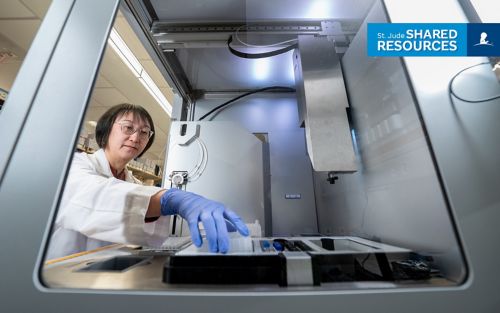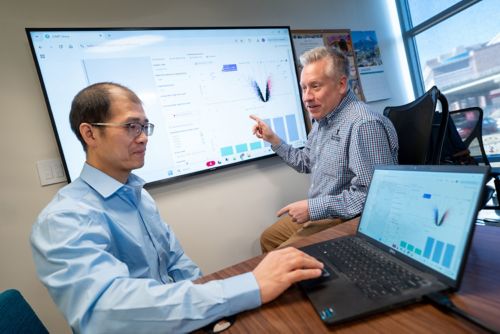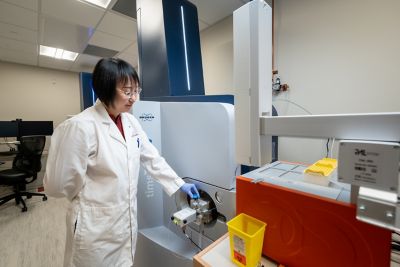St. Jude Family of Websites
Explore our cutting edge research, world-class patient care, career opportunities and more.
St. Jude Children's Research Hospital Home

- Fundraising
St. Jude Family of Websites
Explore our cutting edge research, world-class patient care, career opportunities and more.
St. Jude Children's Research Hospital Home

- Fundraising
Shared Resource Spotlight: Solving complex biological puzzles with the Center for Proteomics and Metabolomics

The St. Jude Center for Proteomics and Metabolomics collaborates to help accelerate discovery.
Every gene, protein and metabolite in the body is a piece of a puzzle that describes human biology. Discovering the origins, earliest signs and underlying mechanisms of disease requires collecting and integrating these puzzle pieces — thousands to millions of tiny clues scattered across a vast biological landscape. Scientists at the St. Jude Center for Proteomics and Metabolomics provide researchers with the expertise, tools and computational methods to combine these clues into cohesive portraits of biology and disease.
“We can take samples from cell or animal models of disease and look at changes in more than 10,000 different proteins and thousands of metabolites,” says Andy High, PhD, who leads the center and its now more than a dozen full-time employees. “We help answer questions, such as, ‘Which proteins are increasing or disappearing? Which are still present but have changed in some way? What metabolites — small molecules — are present or changing?’ Our analyses can help us understand the underlying mechanisms of disease, the downstream effects of a particular genetic mutation or the impacts of a drug treatment.”
High and his team use the latest mass spectrometry technology combined with the latest proteomic, metabolomic and bioinformatic tools to put the pieces of these biological puzzles into place. Mass spectrometry can identify molecules in a sample, from proteins to small molecules to lipids, by breaking them into smaller charged particles and looking for patterns in their masses and charges. The center houses five different types of mass spectrometers in over 2,200 square feet. However, state-of-the-art equipment is only part of the center’s recipe for success — collaborative experimental design, sample preparation and innovative data analysis are equally critical.
A deeply collaborative process

Lead research scientist Zuo-Fei Yuan, PhD, and center director Andy High, PhD, discuss a project in the Center for Proteomics and Metabolomics.
The center is a collaborative and innovative partner in discovery. Well before a biological sample from a St. Jude research lab arrives at the center, High’s team works with the lab to understand their research questions and determine the best analysis methods. High often attends lab meetings to understand researchers’ sample preparation and analysis needs better. His team also follows up with research teams after data collection to ensure researchers can understand, interpret and apply the findings.
“Everything we do is about making the data usable,” says High. “Data is only as good as someone’s ability to act on it.”
The center offers various proteomics and metabolomics services. High’s team regularly helps researchers identify and characterize individual purified proteins or complete sets of proteins in various biological samples. The team can also analyze protein post-translational modifications, such as phosphorylation, to help researchers understand how proteins may change across disease or drug treatment conditions. In recent years, the center has also added metabolomics and lipidomics services, assisting researchers in identifying and quantifying small molecules called metabolites and lipids in their samples.
The power of proteomics: Individual and global insights
Vishwajeeth Pagala, PhD is a senior scientist who manages the day-to-day operations of the proteomics component of the Center for Proteomics and Metabolomics. He helps the center handle myriad proteomics services, from routine protein identification to global proteomics studies. For example, he regularly handles analyses to verify the identity of a purified protein.
“Let’s say a researcher is working to characterize the structure of a specific protein,” says Pagala. “Once they purify the protein from a cell designed to express it, they might want to ensure they have the right protein, that it’s intact, or that it has any intended modifications before proceeding with further characterization. We can run mass spectrometry analysis on the protein isolated from a gel to give them that information.”
The team can also look for specific post-translational modifications to disease-associated proteins, such as phosphate groups added to amino acids in a given protein. Researchers may want to know under which conditions these protein modifications appear in cell or animal models of the disease. Identifying these modifications is key to understanding disease mechanisms and finding new therapeutic targets.
The center also provides global-level analyses that look at any or all the proteins in each sample. Mass spectrometry enables the center to identify up to 10,000 different proteins in a single experiment. Global-level analyses like this can also help determine how a cell’s proteome (all the proteins it expresses) changes with disease or identify complex protein pathways and protein–protein interactions involved in disease.
In one example project, Pagala and others at the Center are helping Fabio Demontis, PhD, Department of Developmental Neurobiology, study how aging and disease are associated with muscle cells’ inability to maintain a healthy protein balance.
“A loss of muscle mass is not only associated with aging but also with diseases like cancer,” says Pagala. “If we could understand the mechanisms behind muscle loss, we could better understand and treat diseases worsened by muscle wasting, including some forms of pediatric cancer. We are analyzing this mechanism by working with the Demontis Lab to study proteome changes in muscle cells. Research in these areas may provide interventions to preserve skeletal muscle mass and function and extend the survival of cancer patients and survivors.
Muscle cells must maintain their proteome by recycling old proteins and making new ones. A changing proteome associated with aging in muscle cells impacts muscle function. It could even impact the brain via signaling proteins that transfer messages between the body’s muscles and the brain. Pagala and others at the center are helping Demontis’s lab examine the interplay of skeletal muscle proteome changes and aging. They are also looking for conditions that might aggravate proteome changes, such as stress, and potential interventions.

Senior Scientist Haiyan Tan, PhD, at work in the Center for Proteomics and Metabolomics.
Metabolomics: The next frontier
While proteomic analyses can tell researchers which proteins are in a sample and how they change or interact across time or biological conditions, they don’t answer whether a given protein or protein network is active. Metabolomics, the study of small-molecule metabolites, can help fill this gap.
Senior scientist Haiyan Tan, PhD, who has been with the center since 2012, specializes in metabolomics and lipidomics. “We are looking at the activity of the proteins, not just their presence,” she says. Metabolites (the products of enzyme activity in cells) represent a “fourth level” of biological systems, following DNA, RNA and proteins. By measuring metabolites, scientists can capture the effects of protein activity and how it shifts in disease.
“Researchers often come to us to confirm metabolite changes when a protein pathway they are studying appears deregulated,” says Tan. “Our metabolomics and lipidomics services allow researchers to go beyond proteins to understand exactly how cellular activity changes with disease or drug treatment, for example.”
Tan currently maintains an in-house “fingerprint” library of more than 700 common metabolites to help with the reliable identification of these metabolites in samples. She hopes to continue to grow the center’s reference library of metabolites.
A bright future
Beyond providing routine sample analysis, High’s team is developing new methods to improve the sensitivity and speed of the center’s analyses. In the future, they hope to reliably and quickly analyze smaller samples down to the collection of proteins and metabolites found in a single cell. Such improvement would allow the center to more confidently analyze small and precious biopsy samples from individual patients, to guide diagnosis and personalized treatments.
Pagala is working to speed up the center’s proteomic analyses with a new technique called Data Independent Acquisition (DIA). “What once took weeks or even months can now be done in days,” says Pagala. “It’s a game-changer. The faster we can analyze data, the faster we can move from discovery to meaningful patient interventions.”
DIA characterizes all the charged particles in a sample instead of prioritizing only the most intense ones, as previous methods did. It provides a more unbiased and quantitative analysis of all the molecules in a given sample. However, it requires more advanced data analysis techniques and large reference molecule libraries, which the center is also developing.
Zuo-Fei Yuan, PhD, is a lead research scientist in the center’s bioinformatics efforts, which include developing custom software pipelines for analyzing and interpreting results.
“We are making tools that allow our investigators to better understand and visualize their proteomics and metabolomics data,” Yuan says. “We build our own software tools, like JUMP [Jumbo Mass Spectrometry-based Proteomics Tool], to visualize large datasets. An investigator can click and easily see volcano plots of which proteins are changing, for example. We aim to make the data more usable.”
To develop a more holistic understanding of any given disease, researchers increasingly need to combine genomic insights with proteomics and metabolomics, like assembling the pieces of a giant 3D jigsaw puzzle. The Center for Proteomics and Metabolomics is helping to make such interdisciplinary research possible at St. Jude and beyond.






